- [WJ-R]: 1980s object removal (Castlethorpe/Hanslope area)
- [XCS]: Pending
- [UkTrainSys]: v0.3.2.0 released
- [Object Library]: Preparing...
- [Website]: Fifth version of website launched
 My openBVE videos and other comments from users and
myself can also be found via my YouTube
channel.
My openBVE videos and other comments from users and
myself can also be found via my YouTube
channel.Blog and Progress Updates
July 11, 2010
openBVE v1.2.7.0 released, new Railsimroutes.net site design, Cross-City South v1.31.07 and miscellaneous project updates, Watford Junction to Rugby screenshot featured in the UK’s PC Gamer Magazine, Genova Brignole – Recco route (as far as Genova Nervi) released
Posted by admin on July 11, 2010 at 6:00 amopenBVE v1.2.7.0 released
![]() Today sees the release of openBVE v1.2.7.0, and some interesting changes have taken place. To begin with, the handling of key and joystick buttons has been revised, and key repeat is now possible. This means that you can hold a key down, and after a short delay, the keypress will be repeated continuously until the key is released again. I’m glad that openBVE now supports this functionality, and this is great for quickly moving a power handle to the limit of it’s travel without having to keep tapping the key, or for sounding the horn in a long and loud fashion, for example. The fly-by camera has also been improved, and now, the leading vehicle (of the nearest train) is tracked by the camera, which is great for loco-hauled trains in particular. 🙂
Today sees the release of openBVE v1.2.7.0, and some interesting changes have taken place. To begin with, the handling of key and joystick buttons has been revised, and key repeat is now possible. This means that you can hold a key down, and after a short delay, the keypress will be repeated continuously until the key is released again. I’m glad that openBVE now supports this functionality, and this is great for quickly moving a power handle to the limit of it’s travel without having to keep tapping the key, or for sounding the horn in a long and loud fashion, for example. The fly-by camera has also been improved, and now, the leading vehicle (of the nearest train) is tracked by the camera, which is great for loco-hauled trains in particular. 🙂
Superelevation is now simulated differently as well; in previous versions, when cant was applied, the train would simply rotate around it’s z-axis, but now, the outer wheel is raised instead. Cant is also interpolated better now, leading to smoother transitions between differing levels of cant. I’m currently rebuilding the canted track objects used by my routes to make better use of these openBVE improvements, such that the wheels will remain on the rails when passing along superelevated track, and the cant transitions at either end of such sections:
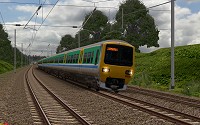 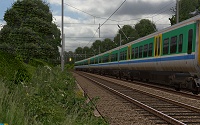 Screenshot showing superelevation in openBVE v1.2.7.0 and Cross-City South v2.0. Note the wheels touching the rails throughout the transition curve (scenery is not finished yet). |
Cant behaviour can also be adjusted now, via the new 'Options.CantBehavior' command. Previously, cant was always applied towards the curve centre, i.e. banking inwards, and this couldn’t be overidden. Also, it wasn’t possible to have cant on straight track. Now though, cant be in either direction, regardless of the direction of the curve, and cant can be applied on straight track too. How might this be useful for simulating a real railway? Well, on the 11th July last year (exactly a year ago as it happens), I was unexpectedly invited for a visit to the preserved Gloucestershire and Warwickshire Railway, and this line has a curve known as Chicken curve, and one peculiar feature was that the cant at this location leaned outward from the curve rather than inwards. So, openBVE can simulate this too, now. Class 20 “chopper” (20154) was our traction on the day, and here’s a photo for fans of the class 20, which I took before we departed from Toddington:
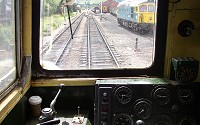 In the cab of a class 20 loco at Toddington, on the preserved Gloucestershire and Warwickshire Railway. |
The simulation of track inaccuracy has been overhauled, too. Previously, the familiar cab and vehicle sway was achieved with horizontal and vertical movement, but now, cant inaccuracy and bounce is also modelled, and cars rock from side to side as well as moving vertically and horizontally. While we were testing the new inaccuracy model, I found that this was an interesting way to represent the effect of travelling over more poorly maintained jointed rails. I’ve made some adjustments to the track accuracy in the newly udpated Cross-City South v1.31.07 (see below for download), and travelling over pointwork or on the jointed rail sections of the Cross-City South, should be a little more interesting now, especially when the class 323’s 3D cab is used. 🙂
Essentially, I think .Accuracy values of 0 to 2.0 are suitable for continuous welded rail, and values of 2.1 to 4 are suitable for jointed rails. I’m aware that not everyone may be sure about the new inaccuracy model, however I think it works well when used sensibly, and I would also point out that the development release has been publicly available for testing for at least three weeks, so if you don’t like it, you’ve missed your chance to give feedback prior to the latest stable release. Nevertheless, if you have any comments, please let us know. Personally I prefer the new algorithm and enjoy the representation it can give when accompanied by the sounds of jointed rails, but some may prefer the old; please give it a try with the updated Cross-City South v1.31.07 and class 323 3D cab though (see below), as this update shows what the new inaccuracy model can do. Also bear in mind that you may only prefer the old algorithm because you’re used to it, not because it was more realistic; the old algorithm had it’s limitations.
Also, BVE4 style timetable textures can now be displayed when 3D cabs are used, and not just with legacy 2D panels, although this is considered an experimental feature. The timetable texture can be shown as part of the in-game user interface overlay, or as part of a 3D cab (animated object); if the latter is not specifically catered for within the 3D cab, then the former is the default behaviour. Adding BVE4 style timetables to a 3D cab is easy to do; I would recommend simply creating an object with a four-vertex mesh and default texture applied (which is shown if there is no timetable image to display), and add this object to your panel.animated file. Then, make use of the new 'TextureOverride =' command:
CreateMeshBuilder
AddVertex,-0.35,2.9,11.52
AddVertex,-0.06,2.9,11.52
AddVertex,-0.06,2.6,11.52
AddVertex,-0.35,2.6,11.52
AddFace,0,1,2,3
LoadTexture,some_suitable_default_texture.png
SetTextureCoordinates,0, 0, 0
SetTextureCoordinates,1, 1, 0
SetTextureCoordinates,2, 1, 1
SetTextureCoordinates,3, 0, 1
[Object]
States = 3d_cab\timetable.csv
TextureOverride = timetable
I’ve added the aforementioned timetable functionality to the class 323’s 3D cab, but it’s commented out by default, as displaying the timetable images via openBVE’s UI overlay makes more sense where the Cross-City South and class 323 are concerned, plus the feature is still experimental.
You can download the update here, and if you want to experiment with the 'TextureOverride =' command, please see the included ‘Readme_3DCab.txt’ file:
→ 3D cab for unrefurbished class 323 – July 2010 [1.7 MiB]
For more detailed information about the new cant behaviour, and timetable support in .animated objects, please read the official openBVE documentation. For details of all the changes introduced with the v1.2.7.0 release of openBVE, including those not mentioned here, please see the changelog.
Cross-City South v1.31.07 update
![]() As openBVE v1.2.7.0 has been released, I’ve updated Cross-City South v1.31 to remove an obsolete timetable texture, changed some of the timetable images to make them suitable for both openBVE and BVE4, and made adjustments to track inaccuracy to take better advantage of openBVE v1.2.7.0’s new track inaccuracy model. I’ve renamed the route folders to more clearly indicate which sets of routes should be used with openBVE, BVE 4 or BVE 2, as well. I’ve also decided to finally split the openBVE routes away from the BVE 4 routes, as testing every openBVE improvement across numerous route files for 100% backwards compatibility with BVE 4 is somewhat inconvenient, and this also lets me get rid of all those pesky "detail levels" in the openBVE route folder, as these simply aren’t needed with openBVE. The new naming convention is as follows, and should be much clearer (the BVE 2 foldername is as it is, so it’ll fit within the size constraints of BVE 2’s small file selection list):
As openBVE v1.2.7.0 has been released, I’ve updated Cross-City South v1.31 to remove an obsolete timetable texture, changed some of the timetable images to make them suitable for both openBVE and BVE4, and made adjustments to track inaccuracy to take better advantage of openBVE v1.2.7.0’s new track inaccuracy model. I’ve renamed the route folders to more clearly indicate which sets of routes should be used with openBVE, BVE 4 or BVE 2, as well. I’ve also decided to finally split the openBVE routes away from the BVE 4 routes, as testing every openBVE improvement across numerous route files for 100% backwards compatibility with BVE 4 is somewhat inconvenient, and this also lets me get rid of all those pesky "detail levels" in the openBVE route folder, as these simply aren’t needed with openBVE. The new naming convention is as follows, and should be much clearer (the BVE 2 foldername is as it is, so it’ll fit within the size constraints of BVE 2’s small file selection list):
- <YourPath>\Railway\Route\Bham_XCitySouth_BVE2\
- <YourPath>\Railway\Route\Birmingham_Cross-City_South_BVE4\
- <YourPath>\Railway\Route\Birmingham_Cross-City_South_openBVE\
Cross-City South v1.31.05 users can download a smaller update here, which updates v1.31.05 to v1.31.07:
→ v1.31.07 update for existing Cross-City South v1.31.05 users [1.03 MiB]
If you have an earlier version of Cross-City South installed, or you’re not sure which version you already have, please download the full version instead.
Genova Brignole – Recco route (as far as Genova Nervi thus far) for openBVE released
![]() I wanted to mention that a fantastic new route has been released for openBVE, the Italian Genova Brignole – Recco route (as far as Genova Nervi thus far, and 8.1 Km in length). This is one of the most graphically excellent routes I’ve seen to date, with superb textures, and I’m impressed; the route is beautiful. There are some animated objects to enjoy, and staggered catenary as well, which is great to see; pedantic people like me will note that some registration arms pull in the wrong direction, though. 😉
I wanted to mention that a fantastic new route has been released for openBVE, the Italian Genova Brignole – Recco route (as far as Genova Nervi thus far, and 8.1 Km in length). This is one of the most graphically excellent routes I’ve seen to date, with superb textures, and I’m impressed; the route is beautiful. There are some animated objects to enjoy, and staggered catenary as well, which is great to see; pedantic people like me will note that some registration arms pull in the wrong direction, though. 😉
You’ll likely need to read the included PDF instructions before operating the newly released ALn501 – Minuetto v2 train, but it’s well worth the effort. Incidentally, the train comes with some very detailed exterior car objects. These look very nice, although they would benefit from the addition of custom normals to smoothly shade some of the surfaces. Please note that these exterior car objects may have quite an impact on your framerate; even on my Core 2 Quad Q9650 / GeForce GTX 260 system, I get around 30fps in the external view, which is down from anywhere between 80 – 300 fps in the cab view. If you have a slow PC, you may want to stay in the cab. I’m looking forward to seeing this route develop further. 🙂
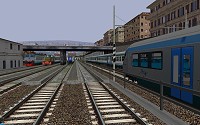 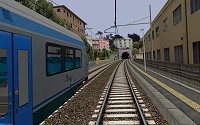 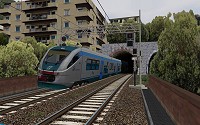 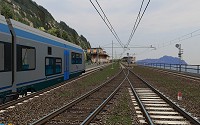 The Italian Genova Brignole – Recco route (as far as Genova Nervi thus far), available from BVEMania (Trenomania) (see the Download section) |
Miscellaneous news
![]() I’m officially announcing the Railsimroutes.net UK Railway Infrastructure Object Library today, which will contain all the objects and textures which are shared between my two upcoming openBVE route projects, Birmingham Cross-City South v2.0, and Watford Junction to Rugby v1.0. This library will be maintained by me, and all developers will be welcome to install and use this library with their own projects, without any conditions or requirement to seek permission.
I’m officially announcing the Railsimroutes.net UK Railway Infrastructure Object Library today, which will contain all the objects and textures which are shared between my two upcoming openBVE route projects, Birmingham Cross-City South v2.0, and Watford Junction to Rugby v1.0. This library will be maintained by me, and all developers will be welcome to install and use this library with their own projects, without any conditions or requirement to seek permission.
The library will contain all sorts of objects, including track, catenary, signals, lineside objects, some basic scenery, and so-on, which might help to make new routes easier to develop. It will also have the advantage, that whenever I update the library, perhaps with higher quality textures or better objects, any routes which call upon the library, will also get updated. I’ll plan it carefully, to ensure that changes remain backwards compatible. I anticipate that the library will be released along with Cross-City South v2.0 initially, and then it’ll receive it’s first update when Watford Junction to Rugby is ready.
 UK Railway Infrastructure Object Library [Now in development] |
Next, as you may have noticed, I’ve decided to increase the version number of my upcoming Cross-City South upgrade for openBVE, from version 1.4, to version 2.0. I think I’m making enough changes and enhancements to the route, to justify a version 2.0 release instead. 🙂
I’ve also updated the openBVE Help and Information section to cover the installation of openBVE in Ubuntu 10.04 (Lucid Lynx). It’s hard to imagine how installing openBVE via the Ubuntu Software Centre could be any easier, and installing openBVE via this method, also makes installing and running the latest official openBVE release with Mono, easier too. I’ve decided to remove the instructions explaining how to run openBVE with Wine, as I’m experiencing problems with the version of Wine available for install with Ubuntu 10.04, relating to GDI+ (and the problem isn’t just occurring with openBVE, either). Perhaps something to do with a Beta release of Wine being supplied rather than a stable release, I don’t know. Running with Mono is much easier though, if you can live without plugin DLLs.
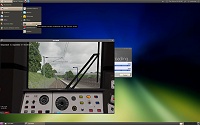 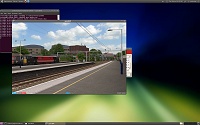 openBVE Help and Information updated for Ubuntu 10.04 users |
I was lucky enough to have one of my screenshots published in the July issue of the UK edition of PC Gamer magazine, where I also gave a brief overview of the work being undertaken on openBVE 2. I will admit that it was nice to handle such a press enquiry! Here’s the screenshot which was chosen for the article, shown amongst screenshots of various simulators, such as Railworks, X-Plane, Sail Simulator, Space Shuttle Mission Simulator, and others:
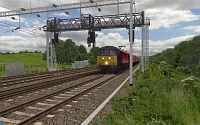 The Watford Junction to Rugby screenshot chosen to appear in simulation article “The Realists”, in the July 2010 issue of the UK edition of the best selling PC Gamer magazine. |
Incidentally, I also want to apologise for the lack of progress with my routes, and for posting so many screenshots and not delivering anything, which I feel that some of you are not impressed by. This is mainly due to me working on openBVE 2, which means that I don’t have much time to devote to the routes at the moment. openBVE 2 is a priority though, and a fantastic experience for me, so I hope fans of my routes will understand. Besides, both routes will run even better in openBVE 2, anyway. I know that the routes look more-or-less finished already, but they’re not – there are such issues as missing track in places, performance optimisations which still to be carried out, and an entire missing station to deal with at Rugby, to name but a few examples. I don’t make a habit of releasing junk and expecting people to be happy with it, so the projects won’t be released until I’m satisfied that a decent standard of quality has been achieved; that doesn’t mean they have to be perfect in every way, just not a disappointment.
New Railsimroutes.net site design
![]() As regular visitors will have hopefully noticed, I’ve redesigned the website, as I felt it needed an update, and I also wanted to put some updated website design skills into practice. The site was last redesigned in 2007 with a theme called “Modern”, characterised by a metallic grey colour scheme and smoothly shaded backgrounds, where Windows users would have been greeted with the Tahoma font throughout, and it was designed to be XHTML 1.0 and CSS Level 2 compliant. However, the content of the site wasn’t reorganised very much since the time of the previous “Retro Blue” design, and over time it became somewhat cluttered and untidy in my view.
As regular visitors will have hopefully noticed, I’ve redesigned the website, as I felt it needed an update, and I also wanted to put some updated website design skills into practice. The site was last redesigned in 2007 with a theme called “Modern”, characterised by a metallic grey colour scheme and smoothly shaded backgrounds, where Windows users would have been greeted with the Tahoma font throughout, and it was designed to be XHTML 1.0 and CSS Level 2 compliant. However, the content of the site wasn’t reorganised very much since the time of the previous “Retro Blue” design, and over time it became somewhat cluttered and untidy in my view.
This latest redesign is the fourth incarnation of the site, with a new theme called “Clarity” (hopefully it might live up to it’s name ;)). The new design is meant to be clearer, better organised, and easier to read. The site has been completely rebuilt from scratch; PHP is now used as well as HTML, and much of the site is XHTML 1.1 and CSS Level 3 compliant. I’ve tested the new site using Firefox 3, Internet Explorer 8, Opera 10, Chrome 5, and Safari 5, and everything works well. The site also works just fine in Internet Explorer 7 and earlier too (tested as far back as IE 5.5), but if you use one of those older Microsoft browsers, you might notice a minor rendering issue around the style selector dropdown box in the footer of each page. Essentially, I’m not happy having to devote much time to dealing with the quirks of browsers which aren’t properly compliant with more recent web standards, partly because it’s just annoying, but also because catering for them can lead to such browsers outliving their welcome (IE 6 springs to mind!). So, if you use Internet Explorer 7 or earlier and want perfect rendering, I would recommend upgrading to Internet Explorer 8 if possible, which is just fine.
I’ve also decided to reorganise the content of the site somewhat. The navigation bar has been expanded with the addition of Gallery and Help links, and the Projects and Downloads section has been overhauled to place emphasis on active projects, and non-help related information. Much more background information and history concerning my route projects is provided now, and information and downloads should be easier to find when they’re ready for release. You’ll also find a "What I’m currently working on" infobox at the top right of this page, which you can check to see what I’m up to, between blog posts. 🙂
I’ve taken the decision to remove some old sections of the site which never received much of my attention, and I’ve moved my old BVE 2 and 4 add-ons into their own de-emphasised legacy add-ons section, as they’re not really reflective of the quality of work I’m now producing; the emphasis is now placed on my upcoming openBVE projects instead. I’ve also introduced a sitemap, as a couple of people have indicated that some information was harder to find, previously.
I’ve also used a different selection of fonts this time:
- Windows 7 and Vista users will get the Segoe UI font throughout (along with the rather nice Consolas for code snippets), giving the best appearance.
- Windows XP users will also get the Segoe UI font, if Windows Live Essentials applications have been installed (for example, Messenger, Mail, Photo Gallery or Writer), or if Office 2007/2010 has been installed. XP users will also get the Consolas font with Office 2007/2010, or this can be downloaded free from Microsoft’s website. If neither Windows Live Essentials or Office 2007/2010 have been installed, but the free Microsoft Powerpoint Viewer 2007 is installed, then Candara (along with Consolas) will be seen instead. If none of these have been installed, then Trebuchet MS (along with Courier New for code snippets) will be seen, which are fonts included with Windows XP.
- Others will likely see generic sans serif and monospace fonts (although these look very nice in Ubuntu Linux, for example).
Incidentally, I experimented with CSS3’s @font-face declaration for embedding fonts, so that a consistent text style would be seen regardless of which fonts are installed locally on someone’s computer. This does indeed work fine, but I haven’t yet decided upon a set of fonts which I like, and which are also released with acceptable non-restrictive licencing terms, so that I can host the fonts on my own server without issues. I’ll explore this again in future, however.
More observant visitors will have noticed that I’ve also renamed the site slightly. I’ve dropped the “UK” part of “Rail Sim Routes UK”, and the site is now called “Railsimroutes.net” instead. The site is still available via two domain names, railsimroutes.net and railsimroutes.co.uk; I have no plans to retire the .co.uk domain, although you might want to update your bookmarks if you still use it.
Anyway, I hope you like the new Railsimroutes.net design. 🙂
Tags: Animated Objects, Artwork, Cross-City South, Functions, openBVE, openBVE 2, openBVE Community, Screenshots, Site News, Watford Jn to Rugby
Posted in openBVE, openBVE 2, Site News | 34 Comments »
